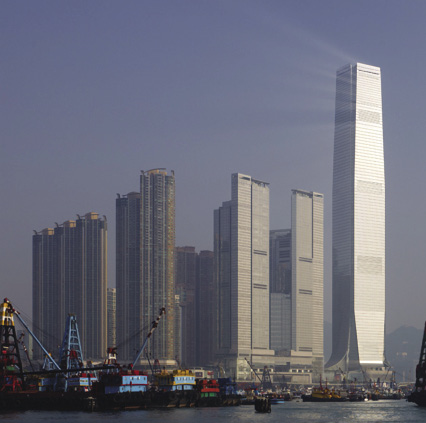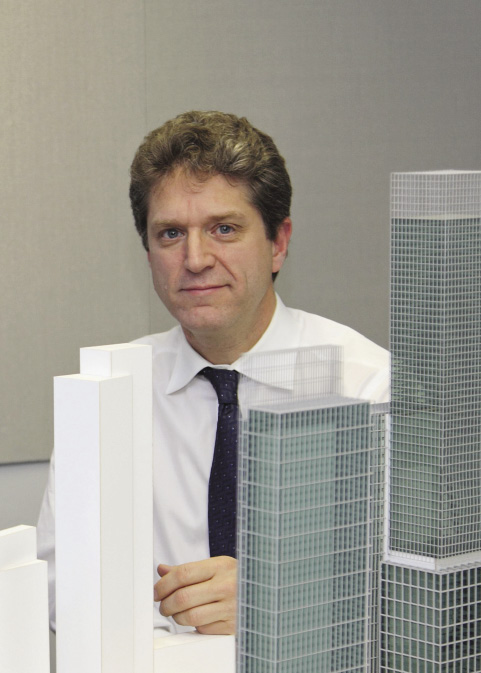Editors’ Note
James von Klemperer has worked as a designer at KPF since 1983 and became a Principal of the firm in 1998. In the United States, his design for the Peterson Institute in Washington D.C. received an AIA award, as did his project for the Mohegan Sun in Connecticut. In China, von Klemperer has completed major mixed-use projects. In Korea, von Klemperer was the chief designer of the Dongbu Financial Tower, winner of an NYAIA award and the Korean National Architecture Award. He has lectured at Harvard, Yale, Columbia, Tongji, Tsinghua, Seoul National, and Yonsei Universities, and at the ESA in Paris. After graduating from Phillips Academy Andover, he received a B.A. Magna Cum Laude from Harvard in 1979. In 1980, he received an M.A. from Trinity College Cambridge. He completed his MArch from Princeton in 1983.
What is the “KPF Approach” and why has the firm succeeded for so many years?
In our field of building design, the greatest accomplishments are most often associated with an individual or master architect. KPF’s success stems in large part from reversing that assumption. We believe that we can produce virtuoso work within a team environment. KPF is a place where young architects can come, driven by the excitement of the newest ideas, and realize them in large-scale projects. Opportunities for experimentation thrive in a place where young people can contribute on even footing with highly experienced architects.
The key to our success is to preserve this horizontal structure. In our design discussions, there is a mixing of generations. It’s a great place for the young architect. This works in reverse fashion as well in that the most senior of our architects do not lose touch with the creative process of drawing, making models, and figuring out how buildings are put together. Students learn from masters and masters learn from newcomers.
Of course, a successful design collaboration relies on the shared values of the participants. As the firm moves ahead, it’s important that we don’t take such common goals for granted. As the firm grows in size, we’re getting into the habit of staging regular firm-wide debates and presentations. We each have to understand how our colleagues think about the various critical subjects: how to devise beautiful proportions, how buildings affect cities, and how architecture can promote the health of our environment. In order for us to lead effectively, it’s important that our ideas are clear and well-articulated.
KPF is known for quality architecture. How do you achieve a high standard of buildings?
The key is a successful marriage of experimentation and execution. Whenever we start a project, we study the established typology of that building, how its plans flow, how functions are organized, and how structures are ordered. Then we think of inventive alternatives – departures from the norm. Thus, the beginning of our design process is not linear. This can require a little more time. We need to try out different ideas in order select the best. At KPF, we do this exploration in the early stages of a job. Our clients come to us precisely because they realize the tremendous value that invention can add to their projects.
Another fundamental aspect of our approach is that we insist on thorough execution in the later stages of building documentation and construction. Some of our competitors deliver design drawings and then diminish their project involvement significantly. We believe that ideals of high design should extend to the nuts and bolts of the construction site.
KPF has done a lot of master planning in Asia, such as Korea’s Songdo IBD, and in various cities in China. Will you tell us about this type of work and about this project in particular?
Urban design and city planning are natural outgrowths of our large scale projects. They both deal with density, public space, and urban culture. These issues are particularly relevant in Asia, where cities are growing quickly. Songdo is one of the few examples of a successful city built from scratch. We have designed the core 20 buildings around the center of that city, defining the quality of space and fleshing out the idea of an urban plan.
The initial driver was a government policy to establish an international free economy zone, to encourage foreign companies to set up businesses in Korea. Another purpose of the city is to be a place for green engineering – to conserve, save energy, and promote a pedestrian environment.
At Songdo, as with the subsequent Chinese projects of Meixi Lake and Langfang, we started with just a blank piece of paper; this forced us to think in both practical and theoretical terms. We started with the positives: studying the basic components and qualities of great cities that we loved and asking, what are the essential spatial structures of city life and how do they work in their cultural contexts? Applying some of the lessons of our dense mixed-use buildings, we proposed a city of overlapping uses.
Avoiding the monocultures of typical edge city developments, the Songdo master plan created overlapping zones – a blending of as many functions as possible. Variation occurs in the urban plan. Different fabrics and geometries come together to create elements of surprise, allowing room for organic growth and unplanned activities to happen over time.

International Commerce Centre
in Hong Kong
How important is being engaged in the community and addressing broader issues in society?
Community involvement is a critical dimension of our work. The impulse is to try to give back by passing on our comprehensive knowledge of large buildings and urban planning to the architecture community. We do this partially through teaching at universities, and speaking frequently at lectures and conferences. We have long established regular intern relationships with educational institutions in the U.S. and Canada, as well as in Japan, Korea, China, and Chile.
In addition, KPF is a member of the United Nations Global Compact and a sponsor of the U.S. Green Building Council: the UGC (New York), UKGBC (United Kingdom), and HKGBC Hong Kong. We participate in the ACE Mentoring Program, a not-for-profit organization that helps prepare high school students for careers in design and construction. We also offer a travelling fellowship program each year, a Student Travel Award organized by The Architecture Foundation, and a year-long externship Construction Company Training Program in collaboration with various construction companies.
Internally, we hold lecture series and panels with guest speakers as well as our regular internal gallery series, where architects and staff can learn about the firm’s current projects. These various sessions not only promote a design dialogue, but also encourage a cultural exchange within the firm and beyond. Our lectures are simulcast to our offices in London, Shanghai, Hong Kong, and Seoul. The main message is: our best work is not necessarily the well-recognized projects found in previously published monographs; it’s the drawings on the wall, the buildings to come.•



